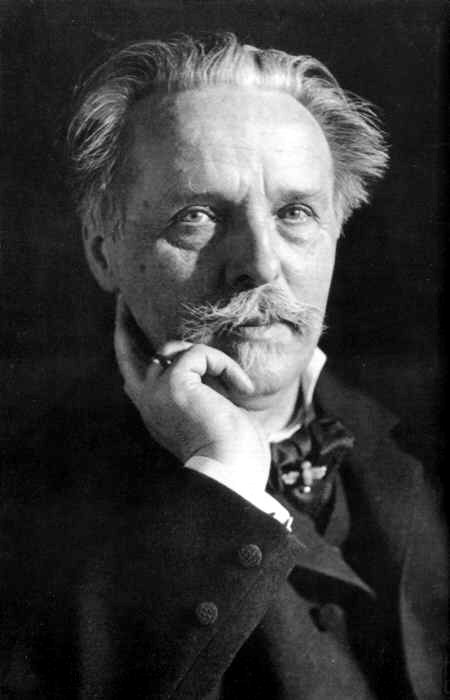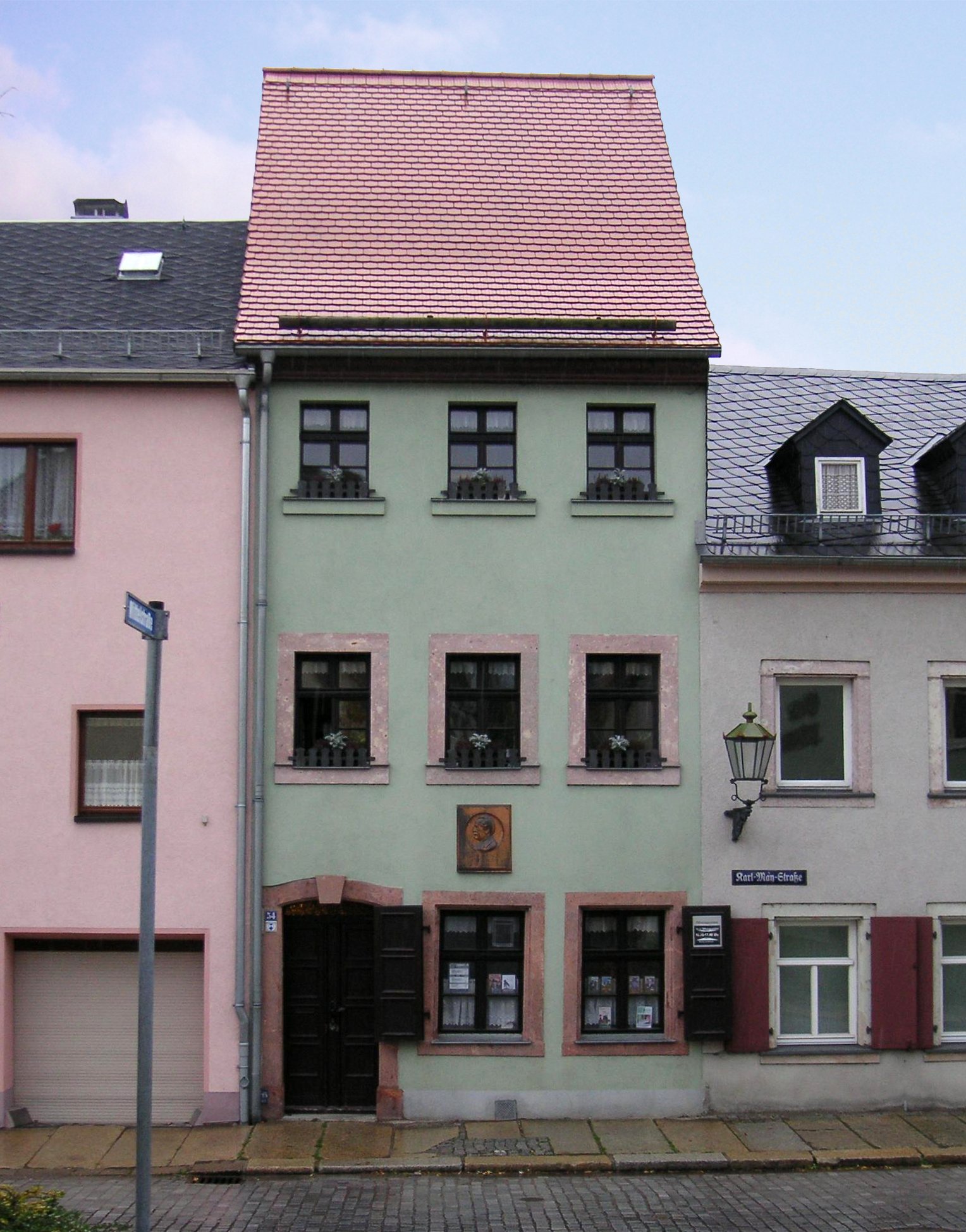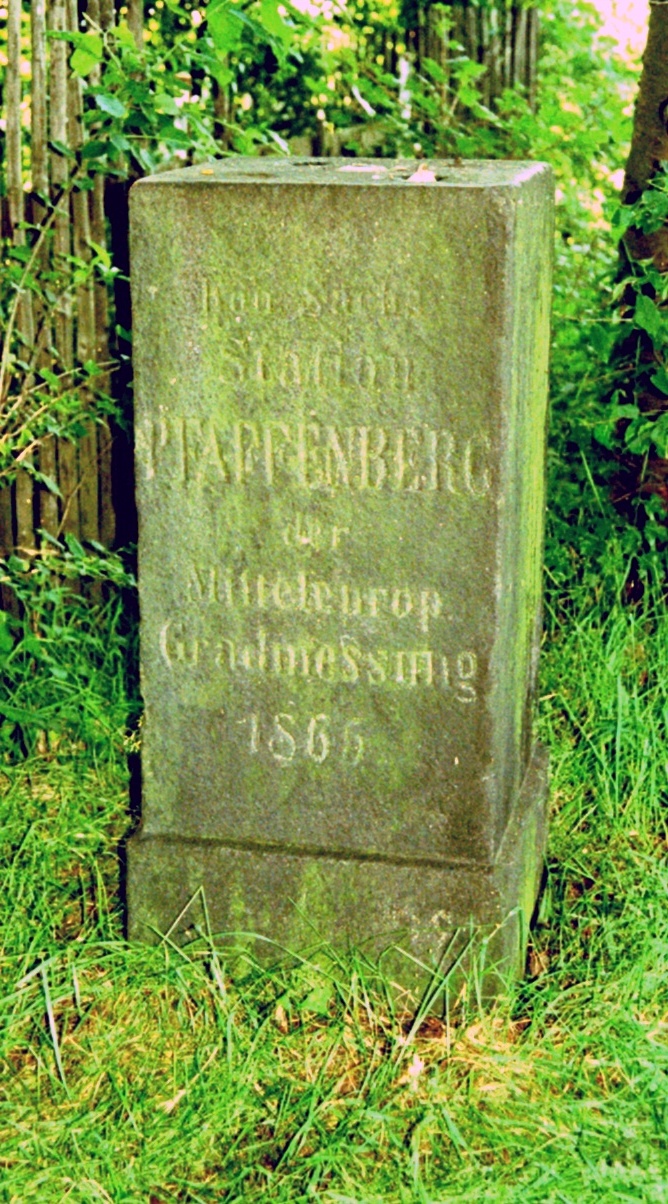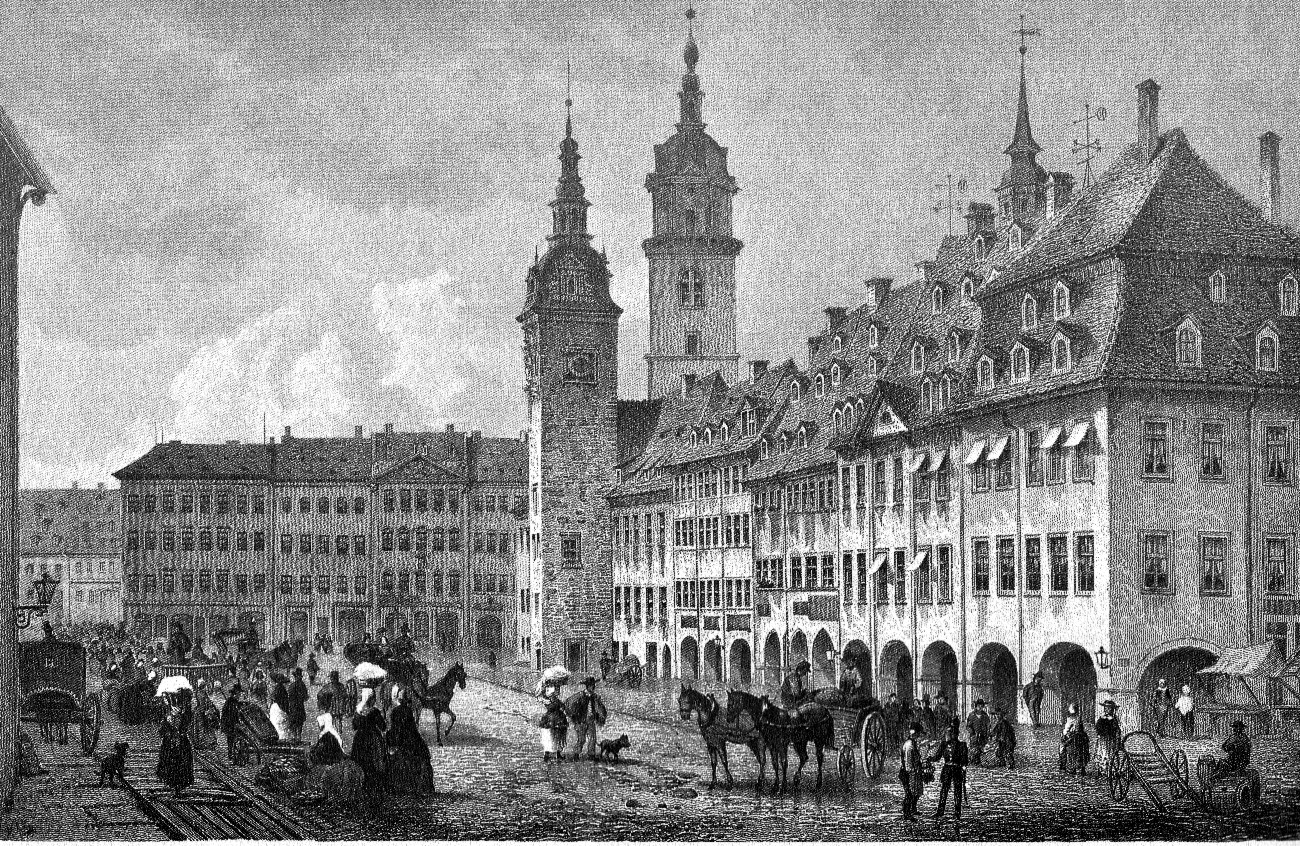|
Hohenstein-Ernstthal
Hohenstein-Ernstthal () is a town in the Zwickau rural district, Saxony, Germany. The towns of Hohenstein and Ernstthal were united in 1898, and the town is either known by its hyphenated form, or simply called Hohenstein. The town grew in the 15th century after silver mines were established nearby. Ernstthal was named in honor of August Ernst von Schoenburg. Physicist Gotthilf Heinrich von Schubert and inventor Christoph Gottlieb Schröter were born in Hohenstein. The writer Karl May was born in Ernstthal. The house of his birth is a museum. Furthermore, Hohenstein-Ernstthal is especially famous for the Sachsenring racing circuit. History In the 15th century, the town of Hohenstein was established after silver was found and mined there. The name is said to be derived from the phrase ″uff dem hohen Stein″ (on the high rock), that the first settlers used when they saw the Pfaffenberg mountain. In 1680 some people from Hohenstein moved to the forest near the town to escape t ... [...More Info...] [...Related Items...] OR: [Wikipedia] [Google] [Baidu] |
Hohenstein-Ernstthal Station
Hohenstein-Ernstthal station is the railway station of Hohenstein-Ernstthal in the south west of the German State of Saxony. The station is classified as a category 5 station by DB Station&Service and has two platform tracks. It is served daily by about 85 trains and is located on the Dresden–Werdau railway. The train station is served only by regional and local trains. History The station, which is located at line-kilometre 98.23 of the Dresden–Werdau railway, was opened on 15 November 1858. At first, the station was in neither Hohenstein nor Ernstthal, but in Oberlungwitz in the district of Abtei. The station site was later purchased by Hohenstein. From 1860 to 1887, the Hohenstein post office was located in the station building. In 1913, the station included 13 tracks. From 17 March 1913 to 26 March 1960, the station forecourt was the starting point of the Hohenstein-Ernstthal–Oelsnitz Tramway. The freight traffic of the tramway was handled ... [...More Info...] [...Related Items...] OR: [Wikipedia] [Google] [Baidu] |
Hohenstein-Ernstthal
Hohenstein-Ernstthal () is a town in the Zwickau rural district, Saxony, Germany. The towns of Hohenstein and Ernstthal were united in 1898, and the town is either known by its hyphenated form, or simply called Hohenstein. The town grew in the 15th century after silver mines were established nearby. Ernstthal was named in honor of August Ernst von Schoenburg. Physicist Gotthilf Heinrich von Schubert and inventor Christoph Gottlieb Schröter were born in Hohenstein. The writer Karl May was born in Ernstthal. The house of his birth is a museum. Furthermore, Hohenstein-Ernstthal is especially famous for the Sachsenring racing circuit. History In the 15th century, the town of Hohenstein was established after silver was found and mined there. The name is said to be derived from the phrase ″uff dem hohen Stein″ (on the high rock), that the first settlers used when they saw the Pfaffenberg mountain. In 1680 some people from Hohenstein moved to the forest near the town to escape t ... [...More Info...] [...Related Items...] OR: [Wikipedia] [Google] [Baidu] |
Dresden–Werdau Railway
The Dresden–Werdau railway is an electrified, double-track main line in the German state of Saxony. It runs from Dresden Dresden (, ; Upper Saxon: ''Dräsdn''; wen, label=Upper Sorbian, Drježdźany) is the capital city of the German state of Saxony and its second most populous city, after Leipzig. It is the 12th most populous city of Germany, the fourth larg ... via Freiberg (Sachs) station, Freiberg, Chemnitz Hauptbahnhof, Chemnitz and Zwickau Hauptbahnhof, Zwickau to Werdau wye, where it joins the Leipzig–Hof railway, Leipzig-Hof railway. The line was opened in several sections and its first section from Werdau to Zwickau was opened 1845, making it one of the List of the first German railways to 1870, oldest railways in Germany. The Dresden–Tharandt section was completed in 1855, the Chemnitz–Zwickau section followed in 1858, the line was extended from Tharandt to Freiberg in 1862 and the section from Chemnitz to Flöha was opened as part of the Annaberg-Buchh ... [...More Info...] [...Related Items...] OR: [Wikipedia] [Google] [Baidu] |
Karl May
Karl Friedrich May ( , ; 25 February 1842 – 30 March 1912) was a German author. He is best known for his 19th century novels of fictitious travels and adventures, set in the American Old West with Winnetou and Old Shatterhand as main protagonists and in the Orient and Middle East with fictional characters Kara Ben Nemsi and Hadschi Halef Omar. May also wrote novels set in Latin America, China and Germany, poetry, a play, and composed music; he was a proficient player of several musical instruments. Many of his works were adapted for film, theatre, audio dramas and comics. Later in his career, May turned to philosophical and spiritual genres. He is one of the best-selling German writers of all time, with about 200,000,000 copies sold worldwide. Life and career Early life May was the fifth child of a poor family of weavers in Ernstthal, Schönburgische Rezessherrschaften (then part of the Kingdom of Saxony). He had 13 siblings, of whom nine died in infancy. His ... [...More Info...] [...Related Items...] OR: [Wikipedia] [Google] [Baidu] |
Sachsenring
The Sachsenring () is a motorsport racing circuit located in Hohenstein-Ernstthal near Chemnitz in Saxony, Germany. Among other events, it features the annual German motorcycle Grand Prix of the FIM Grand Prix motorcycle racing world championship. History The first race was held on 26 May 1927 on an layout on public roads, running also through the village of Hohenstein-Ernstthal itself. It was dubbed "Sachsenring" in 1937. The East German motorcycle Grand Prix was held there from 1961 to 1972. The local two stroke MZ bikes of Zschopau were competitive during this time. The quickest lap was achieved by 15 time World Champion Giacomo Agostini on a MV Agusta with a average. After West German Dieter Braun won in 1971 and the East German fans sang the West German National Anthem in celebration (as is the case in sport, the winner's National Anthem is played after the event), the event was limited to East European entrants for political reasons. In 1990, with faster Western m ... [...More Info...] [...Related Items...] OR: [Wikipedia] [Google] [Baidu] |
Hans-Uwe Pilz
Hans-Uwe Pilz (born 10 November 1958) is a German former footballer. He began his career with BSG Sachsenring Zwickau before joining Dynamo Dresden during the winter break of the 1981–82 season. He remained at Dynamo until German reunification when he moved west, following teammates Matthias Döschner and Andreas Trautmann to Fortuna Köln. However, he returned to Dynamo after a few months, and would play for the club until 1995, including four years in the Bundesliga. After the club suffered a double relegation in 1995, Pilz returned to FSV Zwickau, before retiring in 1997. He later had two brief spells as manager at Zwickau. During his career he won 35 caps for East Germany East Germany, officially the German Democratic Republic (GDR; german: Deutsche Demokratische Republik, , DDR, ), was a country that existed from its creation on 7 October 1949 until its dissolution on 3 October 1990. In these years the state .... References External links * 1958 births ... [...More Info...] [...Related Items...] OR: [Wikipedia] [Google] [Baidu] |
Wüstenbrand Station
Wüstenbrand station is a station on the Dresden–Werdau railway in the south west of the German State of Saxony. In the past, it was a terminus for the secondary lines to Limbach-Oberfrohna and Neuoelsnitz. Currently, it serves as a through station. History The station was built along with the Dresden–Werdau railway in 1858 as a connecting station to the Keilbahnhof ("wedge station", referring to the wedge between the branching tracks) of the (which was later extended to Neuoelsnitz). Using a connecting curve, the coal trains could also run directly to Chemnitz. As early as August 1862, the station had to be expanded, since public passenger and goods traffic to Lugau were permitted from then on. The line to Limbach was opened in 1897 and the system of tracks was expanded again. In 1899, a new entrance building and a workshop were built at a cost of about 85,000 marks for the same reason. Already in the 1950s, the station began to decline and passenger and freight traff ... [...More Info...] [...Related Items...] OR: [Wikipedia] [Google] [Baidu] |
Gotthilf Heinrich Von Schubert
Gotthilf Heinrich von Schubert (26 April 1780, in Hohenstein-Ernstthal – 30 June 1860, in Laufzorn, a village in Oberhaching) was a German physician and naturalist. Biography He began his studies with theology, but turned to medicine and established himself as a doctor in Altenburg, Saxe-Gotha-Altenburg. He soon gave up his practice however and devoted himself to research in Dresden (from 1806). In 1809, by way of mediation from Friedrich Wilhelm Joseph Schelling, he received the post of rector at a secondary school in Nuremberg.Schubert, Gotthilf Heinrich von (bayerischer Personaladel 1853) at Deutsche Biographie He gave renowned lectures on (< ... [...More Info...] [...Related Items...] OR: [Wikipedia] [Google] [Baidu] |
Pfaffenberg (Hohenstein-Ernstthal)
Pfaffenberg is a mountain in Hohenstein-Ernstthal in the state of Saxony, southeastern Germany. It is part of the Saxon Uplands. In the 1860s, the Royal Saxon Triangulation In trigonometry and geometry, triangulation is the process of determining the location of a point by forming triangles to the point from known points. Applications In surveying Specifically in surveying, triangulation involves only angle me ... operated station number 16 on the Pfaffenberg. The triangulation point is still visible. Mountains of Saxony {{Saxony-geo-stub ... [...More Info...] [...Related Items...] OR: [Wikipedia] [Google] [Baidu] |
Zwickau (district)
Zwickau (german: Landkreis Zwickau) is a district ('' Kreis'') in the Free State of Saxony, Germany. History The district was established by merging the former districts Zwickauer Land, Chemnitzer Land and the urban district Zwickau as part of the district reform of August 2008. Geography The district is located in the northern foothills of the Erzgebirge, west of Chemnitz. The main rivers of the district are the Zwickauer Mulde and the Pleiße. It borders (from the west and clockwise) the state Thuringia, the district Mittelsachsen, the urban district Chemnitz, and the districts Erzgebirgskreis and Vogtlandkreis. Towns and municipalities Towns #Crimmitschau #Glauchau # Hartenstein #Hohenstein-Ernstthal # Kirchberg # Lichtenstein #Limbach-Oberfrohna #Meerane # Oberlungwitz # Waldenburg #Werdau #Wildenfels # Wilkau-Haßlau #Zwickau Municipalities # Bernsdorf # Callenberg # Crinitzberg #Dennheritz # Fraureuth # Gersdorf # Hartmannsdorf bei Kirchberg # Hirschfeld # Lange ... [...More Info...] [...Related Items...] OR: [Wikipedia] [Google] [Baidu] |
Chemnitz
Chemnitz (; from 1953 to 1990: Karl-Marx-Stadt , ) is the third-largest city in the German state of Saxony after Leipzig and Dresden. It is the 28th largest city of Germany as well as the fourth largest city in the area of former East Germany after (East) Berlin, Leipzig and Dresden. The city is part of the Central German Metropolitan Region, and lies in the middle of a string of cities sitting in the densely populated northern foreland of the Elster and Ore Mountains, stretching from Plauen in the southwest via Zwickau, Chemnitz and Freiberg to Dresden in the northeast. Located in the Ore Mountain Basin, the city is surrounded by the Ore Mountains to the south and the Central Saxon Hill Country to the north. The city stands on the Chemnitz River (progression: ), which is formed through the confluence of the rivers Zwönitz and Würschnitz in the borough of Altchemnitz. The name of the city as well as the names of the rivers are of Slavic origin. Chemnitz is the third larg ... [...More Info...] [...Related Items...] OR: [Wikipedia] [Google] [Baidu] |
Christoph Gottlieb Schröter
Christoph Gottlieb Schröter (10 August 169920 May 1782), was a German composer and organist, who is best known for his contributions to the tangent piano, which in 1717 he invented a keyboard instrument whose strings were not plucked, but struck by hammers. Biography Born in Hohenstein-Ernstthal, Schröter showed his musical ability as a choirboy in the Staatskapelle Dresden, becoming a student of Johann Christoph Schmidt. In 1717, at the age of 18, he went to the Kreuzschule in Dresden and studied theology. While studying, his mother died, to which he went back to the Staatskapelle to study music and was recommended as a amanuensis to composer Antonio Lotti, which to him was a great honour. Schröter was later employed as a secretary and musical associate to an unknown man, who he would travel with throughout Germany, Netherlands and England. Schröter would later in 1724 settle in Jena where he would teach open lectures about music theory at the University of Jena. In 1726 ... [...More Info...] [...Related Items...] OR: [Wikipedia] [Google] [Baidu] |









.jpg)